July 23rd Scots Book of Days
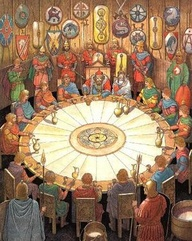 July 23 circa 516 James Knight in his Glasgow and Strathclyde claims “Careful research seems to show, however, that when we trace the Arthurian legends back to their origins we arrive at a real historical person, not a king, but the head of a British federation in Strathclyde, in the century after Ninian. His enemies were the heathen Scots on the west, the Picts on the north, and the Angles on the east, and against these he fought and won twelve battles, the sites of which have all been identified in lowland Scotland. As the result of a victory at Bowden Hill, West Lothian, in 516, he divided the conquered territory among three brothers. To Urien was assigned Reged or northern Stathclyde, Arawn held Scotland beyond the wall as far as Stirling, and Llew or Loth, King of the Picts, Arthur’s brother-in-law and ally, ruled over the eastern territory on the Firth of Forth, now called Lothian. Loth was the father of Thenaw, whose name survives in Tannochside and St. Enoch’s, Glasgow, and she was the mother of Kentigern or Mungo, the real founder of Glasgow and its patron saint, of whom more will be said by-and-by. For twenty years after this victory the land had rest, but in 537 a fresh pagan combination was formed under Modred, Arthur’s nephew, and at Camelot, near Falkirk, a great battle was fought in which both leaders fell, and which overwhelmed Christianity in Scotland for a whole generation.” http://www.templum.freeserve.co.uk/history/strathclyde/arthur.htm pinterest.com. The Round table.
July 23 circa 516 James Knight in his Glasgow and Strathclyde claims “Careful research seems to show, however, that when we trace the Arthurian legends back to their origins we arrive at a real historical person, not a king, but the head of a British federation in Strathclyde, in the century after Ninian. His enemies were the heathen Scots on the west, the Picts on the north, and the Angles on the east, and against these he fought and won twelve battles, the sites of which have all been identified in lowland Scotland. As the result of a victory at Bowden Hill, West Lothian, in 516, he divided the conquered territory among three brothers. To Urien was assigned Reged or northern Stathclyde, Arawn held Scotland beyond the wall as far as Stirling, and Llew or Loth, King of the Picts, Arthur’s brother-in-law and ally, ruled over the eastern territory on the Firth of Forth, now called Lothian. Loth was the father of Thenaw, whose name survives in Tannochside and St. Enoch’s, Glasgow, and she was the mother of Kentigern or Mungo, the real founder of Glasgow and its patron saint, of whom more will be said by-and-by. For twenty years after this victory the land had rest, but in 537 a fresh pagan combination was formed under Modred, Arthur’s nephew, and at Camelot, near Falkirk, a great battle was fought in which both leaders fell, and which overwhelmed Christianity in Scotland for a whole generation.” http://www.templum.freeserve.co.uk/history/strathclyde/arthur.htm pinterest.com. The Round table.
1340 William, 5th Earl of Sutherland took part with the Earl of Dunbar and March in a particularly devastating raid into Northumberland,
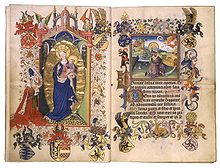 1423 Catherine of Cleves (25 May 1417 – 10 February 1479) (age 6 years) married Arnold, Duke of Guelders, on 23 July 1423
1423 Catherine of Cleves (25 May 1417 – 10 February 1479) (age 6 years) married Arnold, Duke of Guelders, on 23 July 1423
Catherine of Cleves kneels before the Virgin and Child. Her arms, with those of her husband, Duke Arnold of Guelders, are in the bottom center; the arms of her ancestors are in each corner. They become the ancestors of all Scots royal line from James 1st forward, and English from James 6th (1st of England).
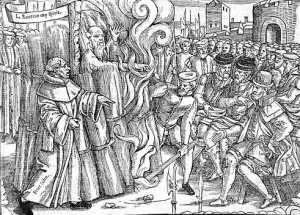 1433 St Andrews. Paul Crawar burnt for heresy. Crawar was a Bohemian physician who adopted the opinions of john Huss. Tytler’s Britannica 89.
1433 St Andrews. Paul Crawar burnt for heresy. Crawar was a Bohemian physician who adopted the opinions of john Huss. Tytler’s Britannica 89.
Wooden cut Burning at the stake.
1536 James V sailed from Pittenween in Fife on 23 July 1536, circum navigated the Isles.
1536 – Henry FitzRoy, died, 1st Duke of Richmond and Somerset, acknowledged natural son of King Henry VIII of England (b. 1519). In 1525, (at age 6) Richmond was appointed Lord High Admiral of England, Lord President of the Council of the North, and Warden of the Marches towards Scotland, the effect of which was to place the government of the north of England in his six year old hands. In February 1527, Thomas Magnus told the young Duke that James V of Scotland (Richmond’s 15 year old 1st cousin) had asked for hunting dogs. Richmond sent the Scottish king 20 hunting hounds and a huntsman.
1544 Siege of St. Dizier France, during the Italian War of 1542, when the Imperial army of Charles V attacked St. Dizier at the beginning of its advance into Champagne.
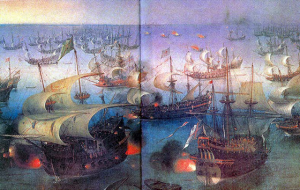 1588 the Armada reached Portland Bill where the wind veered to the North East, giving the weather gauge to the Spanish and enabling them to turn and attack the pursuing English ships. The execution of Mary Queen of Scots in 1587 was the final incentive for the invasion by the Spanish Armada. The Spanish Armada. The decisive action off Calais 27 july 1588; the English attack at midnight led
by the eight fire ships that forced the Spanish to cut their cables and escape to the East. Since 1560, the fortunes of England and Scotland are linked together.
1588 the Armada reached Portland Bill where the wind veered to the North East, giving the weather gauge to the Spanish and enabling them to turn and attack the pursuing English ships. The execution of Mary Queen of Scots in 1587 was the final incentive for the invasion by the Spanish Armada. The Spanish Armada. The decisive action off Calais 27 july 1588; the English attack at midnight led
by the eight fire ships that forced the Spanish to cut their cables and escape to the East. Since 1560, the fortunes of England and Scotland are linked together.
1597 Earthquake. Felt all over the Highlands. 4.6 strength. 2 Nephi 26:6 And they shall be visited with earthquakes, and all manner of destructions, and the day that cometh shall consume them, saith the Lord of Hosts.
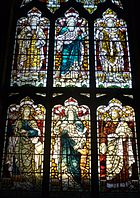 1637 On Sunday 23 July 1637 efforts by King Charles (later styled the 1st) to impose Anglican services on the Church of Scotland led to the Book of Common Prayer revised for Scottish use being introduced in the High Church of St. Giles, Edinburgh.
1637 On Sunday 23 July 1637 efforts by King Charles (later styled the 1st) to impose Anglican services on the Church of Scotland led to the Book of Common Prayer revised for Scottish use being introduced in the High Church of St. Giles, Edinburgh.
Scottish Saints window at St Giles. The dean of the city of Edinburgh, John Hannah, prepared to read the new Book of Prayer service before a numerous concourse of persons, none of whom seem to have been favourably disposed to its reception. As the reader of the prayers announced the Collect for the day, an old woman, named Jenny Geddes, who kept a green stall in the High Street, bawled out —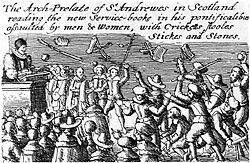 “The deil colick in the wame of thee, thou false thief! dost [TG41-356, Tales of a Grandfather, Chap. 41, p. 356] thou say the mass at my lug?” “A Pope! a Pope! Antichrist! pull him down, stone him!” Jenny Geddes, the very woman who had given the first signal of civil broil, by throwing her stool at the Dean of Edinburgh’s head, when he read the service-book. (TG49-178). The start — riots set off by Jenny Geddes. Insulted Charles 1st fool whispered to the Archbishop of Canterbury. An ancient custom, to have a fool, or jester, maintained at court, privileged to break his satirical jests at random. The post was then held by one Archie
“The deil colick in the wame of thee, thou false thief! dost [TG41-356, Tales of a Grandfather, Chap. 41, p. 356] thou say the mass at my lug?” “A Pope! a Pope! Antichrist! pull him down, stone him!” Jenny Geddes, the very woman who had given the first signal of civil broil, by throwing her stool at the Dean of Edinburgh’s head, when he read the service-book. (TG49-178). The start — riots set off by Jenny Geddes. Insulted Charles 1st fool whispered to the Archbishop of Canterbury. An ancient custom, to have a fool, or jester, maintained at court, privileged to break his satirical jests at random. The post was then held by one Archie 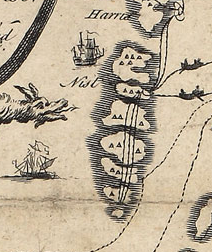 Armstrong. [clan Armstrong] “Who’s fool now, my lord?” For this jest, poor Archie, having been first severely whipped, was disgraced and dismissed from court, where no fool has again been admitted, at least in an avowed and official capacity (as of 1828). (TG 41-357) {Early stand up comic satire.]
Armstrong. [clan Armstrong] “Who’s fool now, my lord?” For this jest, poor Archie, having been first severely whipped, was disgraced and dismissed from court, where no fool has again been admitted, at least in an avowed and official capacity (as of 1828). (TG 41-357) {Early stand up comic satire.]
- Armstrong17th 2Warren2Mehew2Luther2Choate zoe
1745 July 23 PRINCE CHARLES EDWARD STUART Landed at Eriska Island,l and spent the night in a cottage (I. 205, 289).
1773 – Sir Thomas Brisbane, born, Scottish astronomer, soldier and governor of New South Wales (d. 1860)
1777 Fraser’s 71st Highlanders, in Howe’s army, departed from Sandy Hook, New Jersey on July 23, 1777 and landed near Elkton, Maryland in northern Chesapeake Bay.[6] Marching north, the British Army brushed aside American light forces in a few skirmishes. Washington offered battle with his army posted behind Brandywine Creek (battle on September 11, 1777). Many Scottish people flocked to the English cause. In 1778, some 15,000 men were enlisted into the British Army. Two-thirds of them were from Scotland.
Colonel Simon Fraser was the chieftain of the Frasers of Lovat. He raised the 78th Regiment of Foot for the French and Indian Wars. He regained the lands forfeit in 1746, but did not accompany his Regiment to America. He died a Lieutenant General in 1782. The Regiment was officially raised at Stirling Castle and in April 1776 moved to Glasgow 1787 Connecticut Compromise.
1787 Great Compromise of 1787 or Sherman’s Compromise) was an agreement that large and small states reached during the Constitutional Convention of 1787 that in part defined the legislative structure and representation that each state would have under the United States Constitution. It retained the bicameral legislature as proposed by James Madison, (early tutored by a Scot, Donald Robertson) along with proportional representation in the lower house, but required the upper house to be weighted equally between the states.
1793 – Thomas Cochrane, 10th Earl of Dundonald (from 1835 circa) (clan Cochrane) ‘Lord Cochrane’ midshipman in Navy.
1837 Joseph Smith the Prophet, Kirtland, Ohio, (clans Huntley, Hamilton, Mackenzie, Mack of Inverness, Malcolm King of Scots), The Prophet records that this revelation was received on the day on which the gospel was first preached in England. Doctrine and Covenants 112.
1885 – Ulysses S. Grant (clan Grant) died, 18th President of the United States (b. 1822)
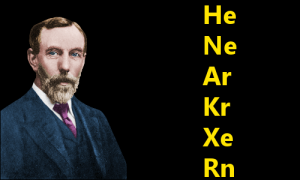 1916 – Sir William Ramsay, died, Scottish chemist, Nobel Prize laureate (n Glasgow on October 2, 1852). (clan Ramsey) in 1872 he became assistant in chemistry at the Anderson College in Glasgow, then Chemistry at University College, Bristol, then Inorganic Chemistry at University College, London. His discoveries included oxides of nitrogen and followed those up with the discovery of argon, helium, neon, krypton, and xenon. Nobel Prize
1916 – Sir William Ramsay, died, Scottish chemist, Nobel Prize laureate (n Glasgow on October 2, 1852). (clan Ramsey) in 1872 he became assistant in chemistry at the Anderson College in Glasgow, then Chemistry at University College, Bristol, then Inorganic Chemistry at University College, London. His discoveries included oxides of nitrogen and followed those up with the discovery of argon, helium, neon, krypton, and xenon. Nobel Prize
Chemical elements in the periodic table – the noble gases.
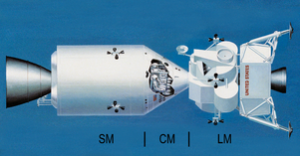 1969 Apollo 11 the first manned landing on the Moon is two-thirds of the way returning to earth.
1969 Apollo 11 the first manned landing on the Moon is two-thirds of the way returning to earth.
Apollo 11 spacecraft. SM: Service Module (no call sign); CM: Command Module, Columbia; LM: Lunar Module, Eagle.
1986 – After securing the Queen’s permission (which is required by a British law, the Royal Marriages Act 1772, for children of the monarch) Andrew Duke of York and Sarah Ferguson were married in Westminster Abbey. Andrew Duke of York and Sarah Ferguson were married in Westminster Abbey on 23 July 1986. Sarah’s full title during her marriage was Her Royal Highness The Princess Andrew Albert Christian Edward, Duchess of York, Countess of Inverness, Baroness Killyleagh.
2004 McAuliffe and all the other 13 astronauts lost in both the 1986 Challenger and 2003 Columbia disasters were posthumously awarded the Congressional Space Medal of Honor by President George W. Bush [his 4th great grandmother, Catherine Walker (nee McLelland), was Scottish.] Ronald McNair, Commander William Cameron McCool, Captain David McDowell Brown, Captain Laurel Blair Salton Clark.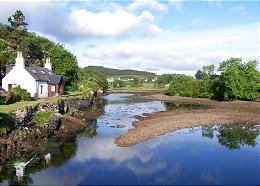
2006 Whirlwind tour takes in Highlands, Isle of Skye, Inverness, Edinburgh and more.
The fishing village of Kyleakin, on the east coast of the Isle of Skye, is across the Skye Bridge from the mainland town of Kyle of Lochalsh.
Ruins of Castle Moil, background on hill, a late 15th -century fortress in Kyleakin, is seen on the east coast of the Isle of Skye off the western coast of Scotland.
http://www.deseretnews.com/article/ 640195808/Great-Scotland.html?pg=all
23 July – 2 August
Crail Festival is celebrating its 30th year!
Disclaimer: The author of each article published on this web site owns his or her own words. The opinions, beliefs and viewpoints expressed by the various authors and forum participants on this site do not necessarily reflect the opinions, beliefs and viewpoints of Utah Standard News or official policies of the USN and may actually reflect positions that USN actively opposes. No claim in public domain or fair use. © John Choate
Utah Standard News depends on the support of readers like you.
Good Journalism requires time, expertise, passion and money. We know you appreciate the coverage here. Please help us to continue as an alternative news website by becoming a subscriber or making a donation. To learn more about our subscription options or make a donation, click here.
To Advertise on UtahStandardNews.com, please contact us at: ed@utahstandardnews.com.


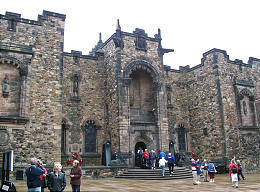
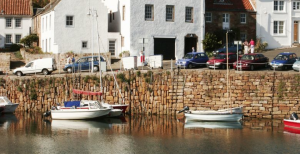
Comments - No Responses to “July 23rd Scots Book of Days”
Sure is empty down here...